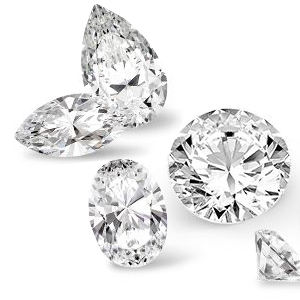Love them or hate them, lab grown diamonds are becoming more prevalent in today’s fine jewelry world. These diamonds have the same chemical makeup and appearance as natural diamonds, but have different origins. While natural diamonds were formed about 100 miles below the earth’s surface roughly one to three billion years ago, lab grown diamonds are created in the controlled setting of a laboratory in a time period of less than a month typically. Here’s everything you need to know about these lab created gems.
Lab grown diamonds first made headlines in 1954 when General Electric created the first man-made diamond. However, until recently, the technology used to create these diamonds wasn’t advanced enough to make it financially worthwhile to produce larger, gem quality diamonds that could be set in fine jewelry. This all changed with recent advances in lab grown diamond technology, allowing companies to produce higher quality diamonds in a relatively fast and more affordable manner.
So how are these gems actually created? Well, there are two common methods used to create lab grown diamonds. The first is the High Pressure, High Temperature (HPHT) process. This process grows diamonds using machines that mimic the extreme pressure and heat conditions that natural diamonds were created from in the Earth’s mantle. During this process, a diamond seed is placed into pure carbon and then exposed to pressures between 725,000 to 870,000 pounds per square inch (PSI) and temperatures between 2,300 and 2,900 degrees Fahrenheit. Over time, a diamond forms around the seed. Diamonds created through the HPHT process usually contain flux metal inclusions.
The other process used to create lab grown diamonds is Chemical Vapor Deposition (CVD). This process starts with a diamond slice or seed placed in a pressure chamber that’s heated to 1,200 to 3,000 degrees Fahrenheit. Unlike HPHT, this method uses a much lower pressure, usually 100 to 550 PSI. Methane and hydrogen gas are then injected into the chamber, forming plasma gas. A microwave beam then breaks down the gas molecules, allowing carbon atoms to be freed and cover the seed, creating a diamond crystal. The diamonds formed through the CVD process typically come out brown or gray, but then go through an annealing process to make them more colorless. Unlike HPHT diamonds, CVD diamonds do not have metallic inclusions, but rather commonly have graphite inclusions or another type of mineral inclusion.
The amount of time needed to grow a lab grown diamond varies depending on the size of the diamond. Microscopic diamonds can be made in mere seconds while diamonds weighing over three carats can take up to three months to form.
After a lab grown diamond is formed, it is typically sent to India, where almost 99% of these lab created gems are cut.
It’s important to note that while lab grown diamonds currently cost about 30% less than natural diamonds, their price may decrease even more over time. As the technology used to create these gems improves and more companies begin manufacturing these diamonds, many experts believe we’ll see lab grown diamonds decrease in value in future years. More information on how lab grown diamonds compare to natural diamonds can be found here.
If you have any questions regarding lab grown diamonds or want to see how they compare to natural diamonds in-person, feel free to contact Kloiber Jewelers at 414-276-2457 or info@kloiberjewelers.com.


